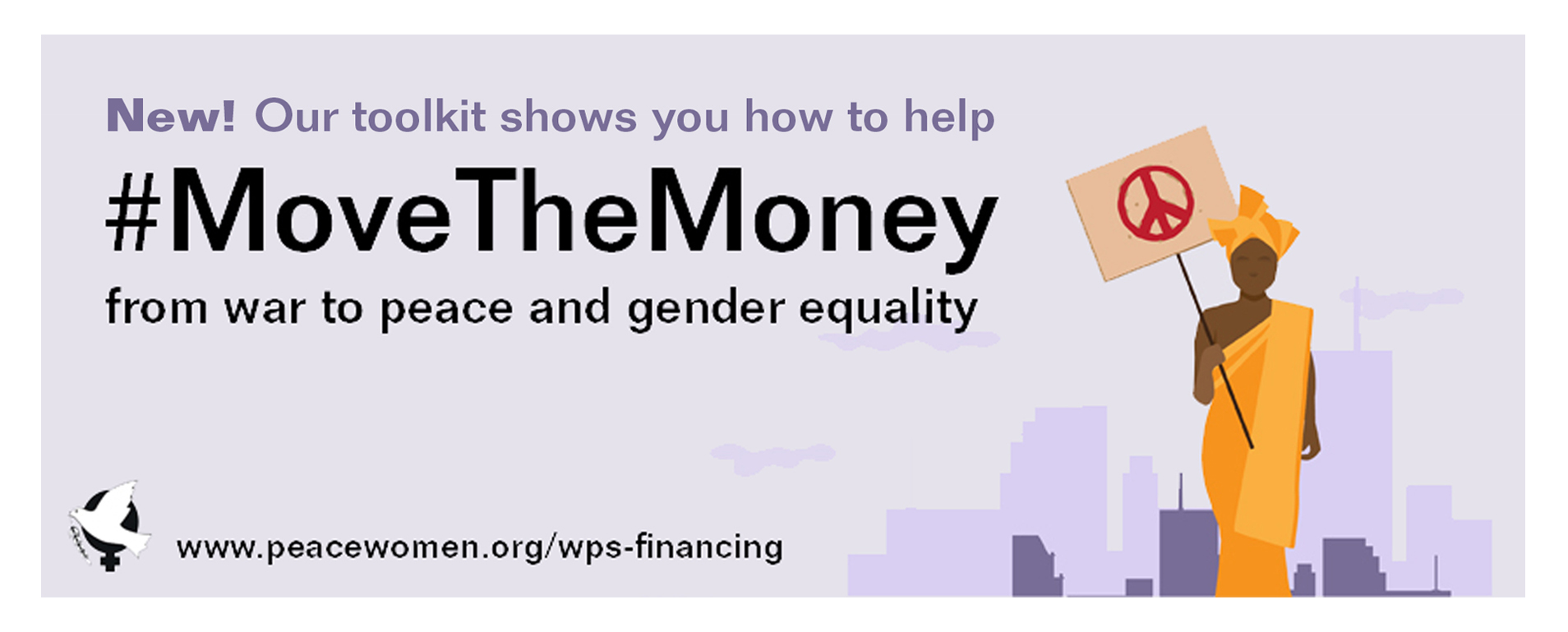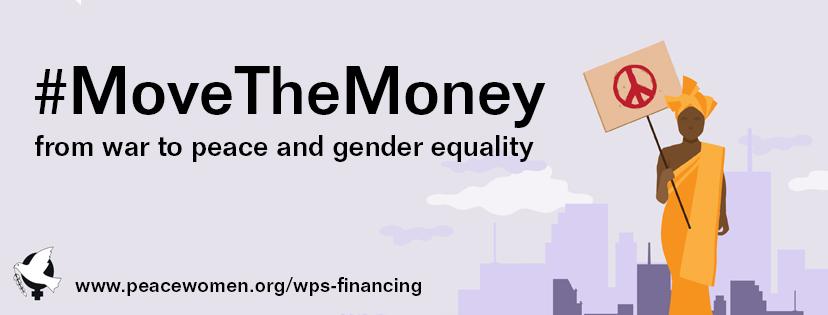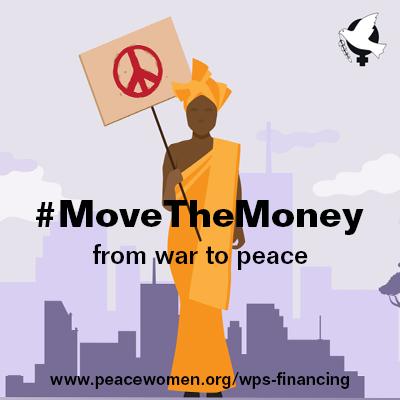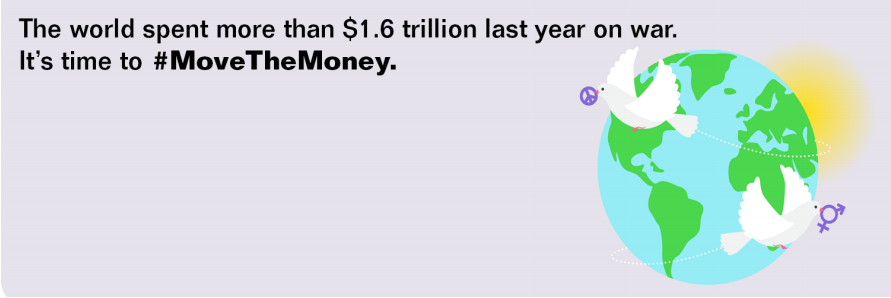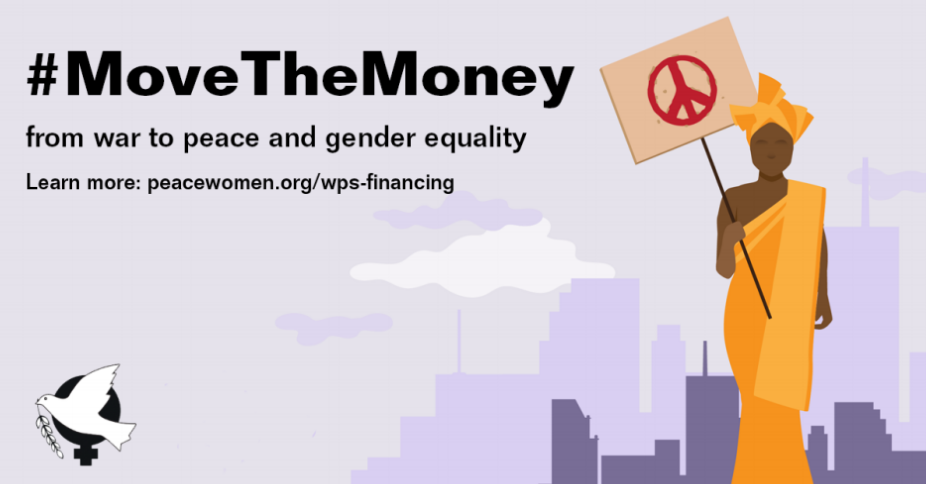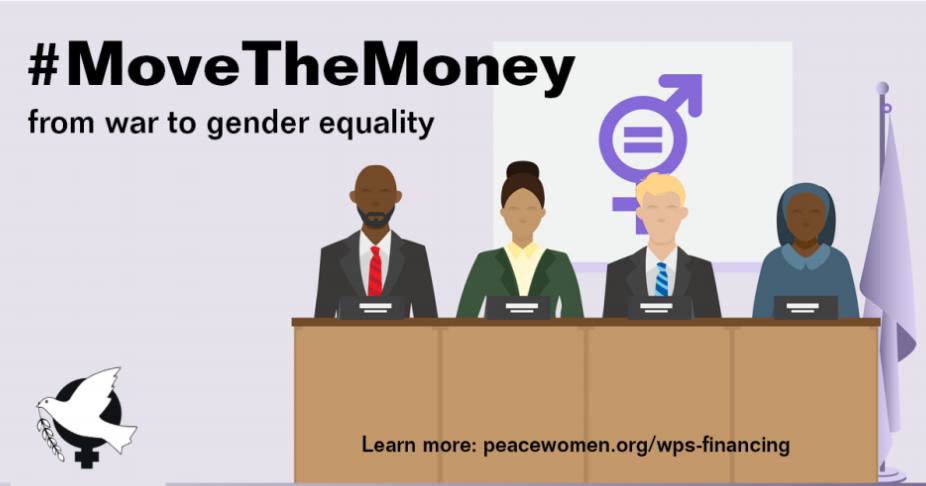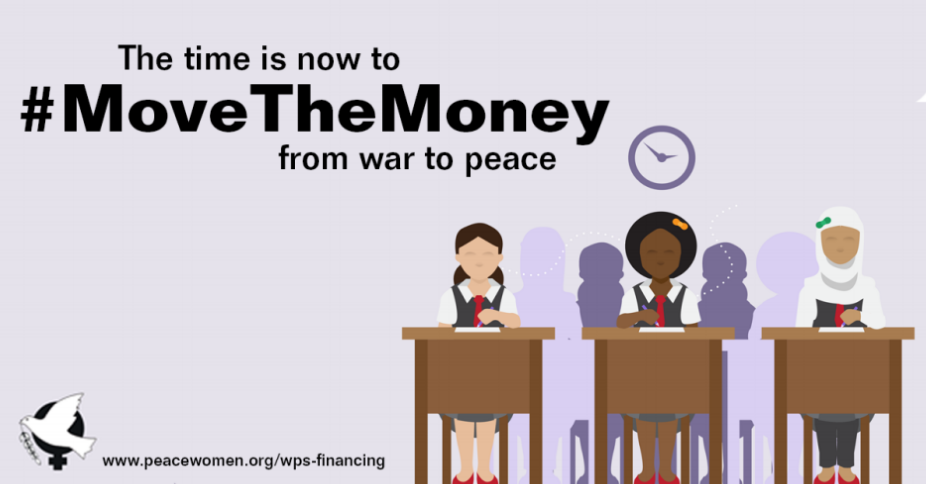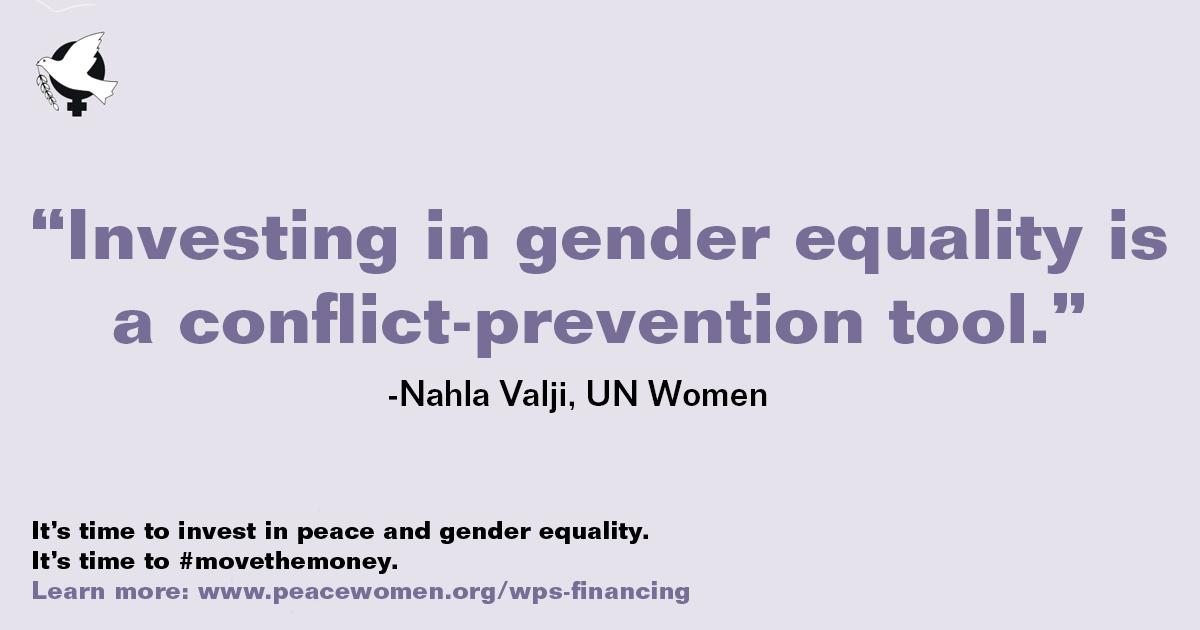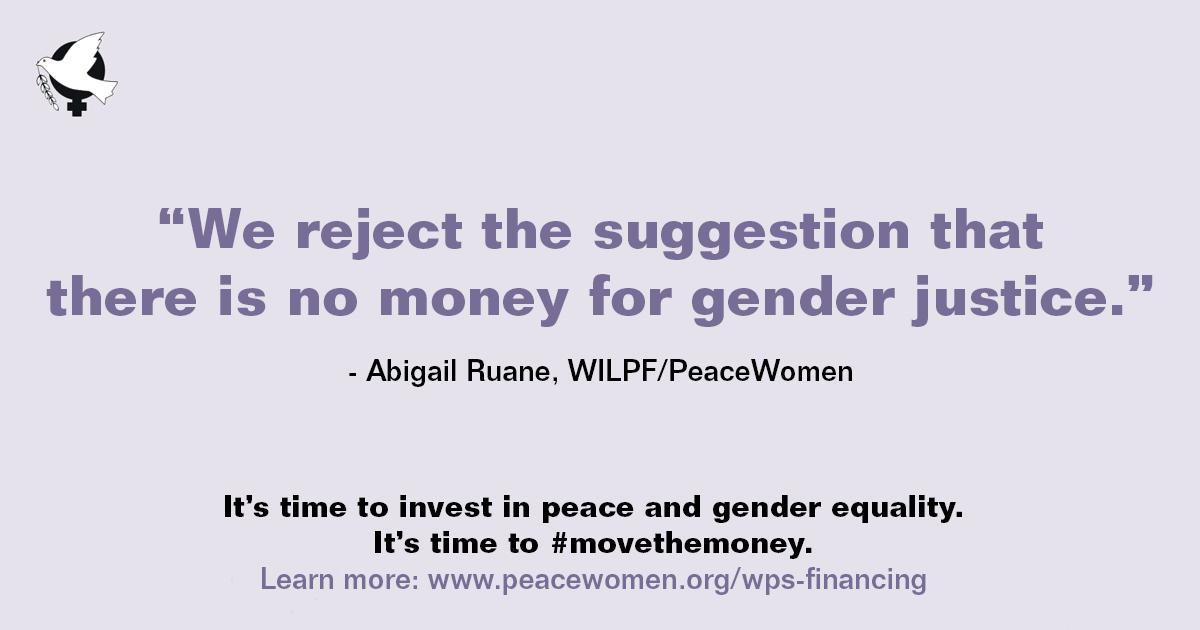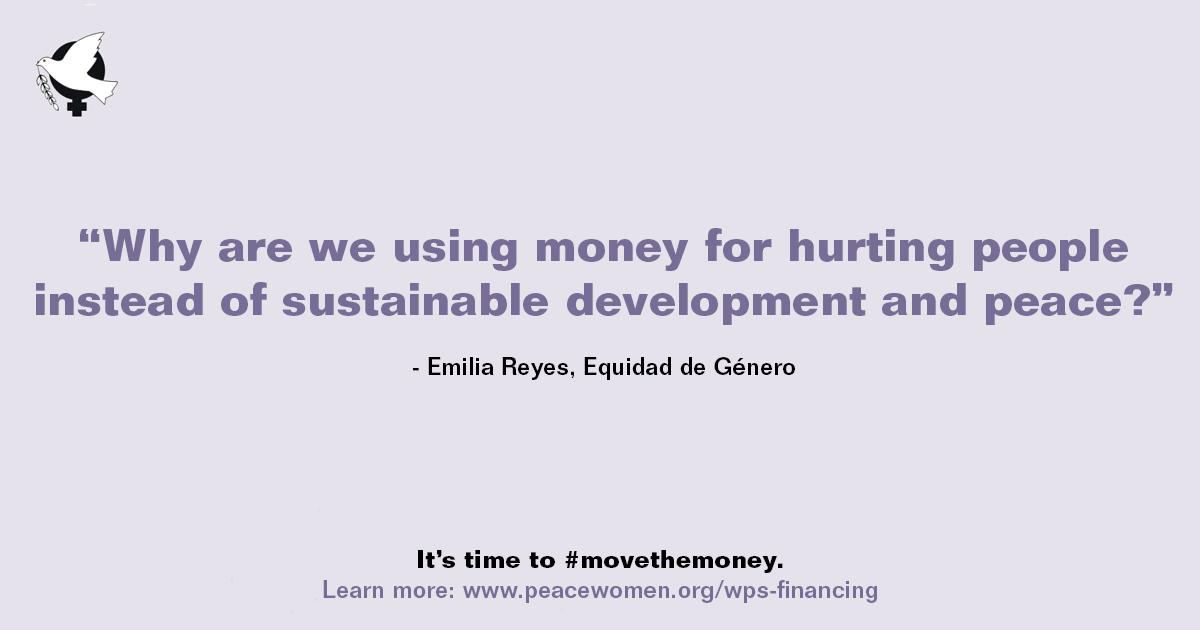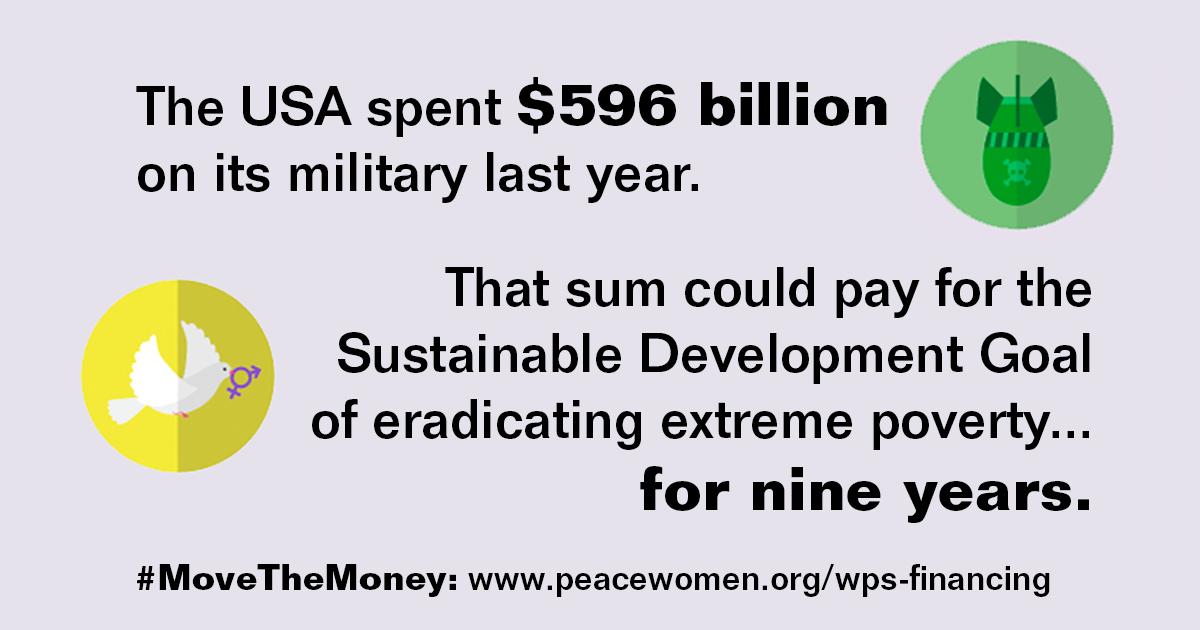Women, Peace and Security Financing
In 2018, there was a global military spend of $1.8 trillion (SIPRI). Meanwhile, gender equality and peace remain drastically under-funded: As the 2015 Global Study on UNSCR 1325 (Global Study) found, there is a “consistent, striking disparity between policy commitments to gender equality and women’s empowerment, and the financial allocations to achieve them” (p. 372).
Women’s rights are human rights, and progressively realising those rights using the maximum available resources is a state obligation. Investing in women also brings significant benefits. Despite this, women’s contribution to conflict prevention and peace remains undervalued and under-resourced.
It is time to recognise that you get what you pay for: trillions on war and pennies for peace will only lead to violence. It is time to invest in gender equality and social justice policies and movements for peace.
At the top of the page, you’ll see an interactive slider with graphics that show military spending and how we need to “Move the Money” to fund Women, Peace and Security initiatives. On the subpages linked below, you can find more information on why Women, Peace and Security financing matters, plus some resources to help you spread the message: It’s time to #MoveTheMoney.
>>Watch the video in French (Regardez la vidéo ci-dessus en français)
>>Watch the video in Spanish (En el vídeo, en español)
>>Watch the video in Portugese (Assista ao vídeo acima em português)
>>Watch the video in Arabic (مشاهدة فيديو باللغة العربية)
>>Watch the video in Korean (한국어로 비디오보기)
>>Read the overview document about the WPS Financing Toolkit
>>Read the press release announcing WPS Financing Toolkit launch
>>Read the report on the WPS Financing workshop in July, 2016
>>Watch Cynthia Enloe's webinar about militarism and gender, presented at our WPS Financing Workshop
Why Women, Peace and Security? radhika
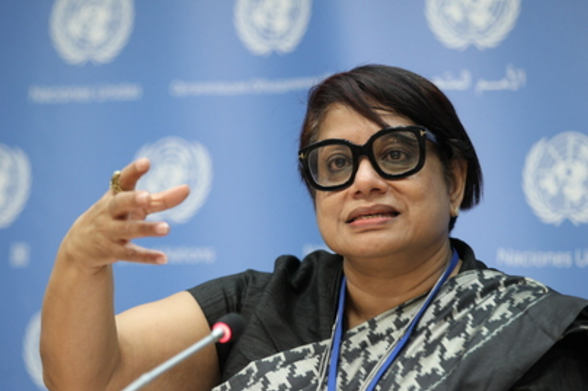
If the international community wants peace and security, it cannot keep investing in a political economy of war and divesting a political economy of gender justice and peace. Learn key messaging and evidence for why it is critical to #MoveTheMoney!
>>Read more about why WPS Financing matters
Security Council and Women, Peace and Security Financing security council.jpg
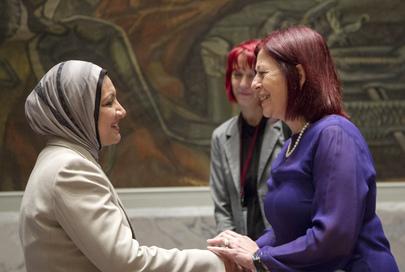
Security Council members are obligated to implement the Women, Peace and Security agenda as Member States and also have other particular responsibilities as leaders at the UN on peace and security issues. However, the Permanent Five members of the Security Council (United States, United Kingdom, France, Russia, China) are also some of the top military spenders in the world. Since arms proliferation and associated violent masculinities directly contribute to sexual and gender-based violence and conflict, demilitarisation and disarmament are critical to addressing a major gap on conflict prevention in the Women, Peace and Security Agenda.
>>Read more about the Security Council
Member States and Women, Peace and Security Financing
Timorese kids.jpg
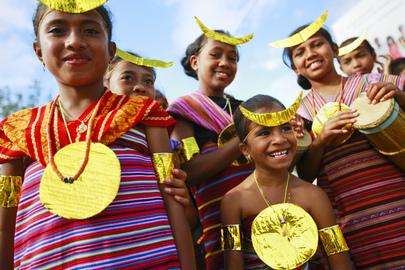
Member States are responsible for implementing the Women, Peace and Security Agenda at a national level. National Action Plans (NAPs) and Regional Action Plans (RAPs) on UNSCR 1325 are one key mechanism for implementation. Although the 2015 Global Study on UNSCR 1325 affirmed that NAPs should include an allocated budget, most fail to do so, which weakens accountability and impact.
>>Read more about Member States
United Nations and International Financial Institutions and Women, Peace and Security Financing BanKiMoon.jpg
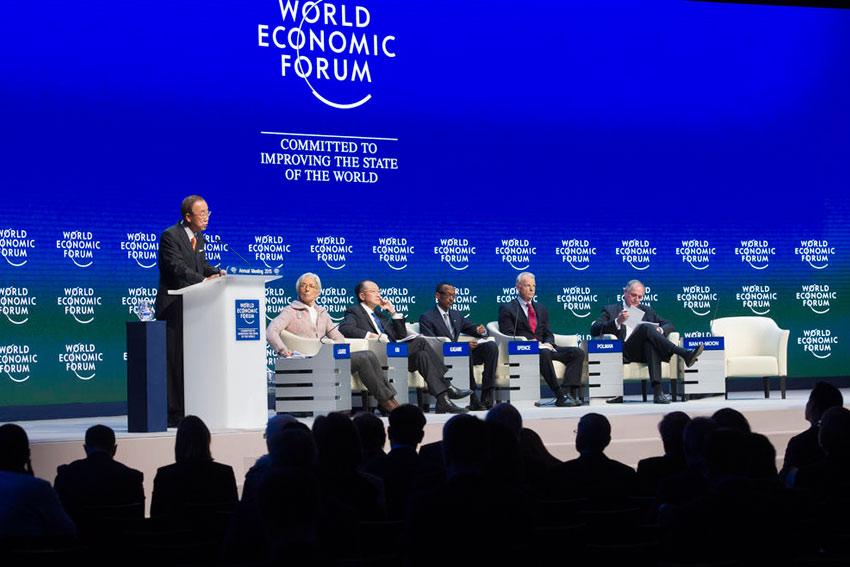
International Financial Institutions (IFIs) have their own part to play in implementing the Women, Peace and Security agenda. Efforts to mainstream a gender and conflict lens, such as the World Bank’s 2016-2023 Gender Strategy are key to taking action. However, a holistic gender and conflict lens that recognises gender equality considerations in human rights, good governance, and capacity-building agendas is still largely lacking.
To move forward, international financial institutions must support structurally transformative action, as advocated for by the Addis Ababa Action Plan on Transformative Financing for Gender Equality and Women’s Empowerment. This action must strengthen and finance domestic, international, and enabling environment policy actions and resources for gender equality and women's rights with a particular emphasis on conflict affected states.
A recent funding initiative that aims for good practice principles is the Global Acceleration Instrument (GAI) for Women, Peace and Security and Humanitarian Action, a new pooled funding mechanism, which includes civil society in both its governance and its priority areas of funding.
>>Read more about the United Nations
>>Read more about the Global Acceleration Instrument
Civil Society and Women, Peace and Security Financing
protest nigeria
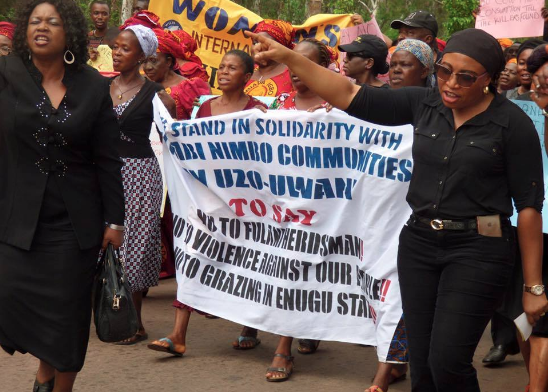
Civil society was the prime driver behind the original Women, Peace and Security Agenda, the product of over 100 years of international women’s peace activism.
Civil society organisations (CSOs) continue to push for the full and effective implementation of the Women, Peace and Security Agenda, using the Global Study as a powerful advocacy tool.
However, the international community has failed to allocate sufficient funds and resources to this implementation. All too often, women’s organisations dedicated to conflict resolution and peacebuilding receive funding for specific short-term projects rather than core funding, and are forced to spend a disproportionate amount of time focusing on activities to raise funds. Several Women, Peace and Security UN Security Council Resolutions including UNSCR 2242 (2015) recognise the key role civil society plays in implementation of the Women, Peace and Security Agenda, and call on Member States to increase their fundings for civil society which work for the implementation of the Agenda. However, urgent action must be taken to address this critical gap.
>>Read more about Civil Society Organisations
>>Read more about civil society funding sources from AWID
>>Good Practice Case Study: Engaging the media on the Women, Peace and Security Agenda in Cameroon
Advocacy and Media Outreach peace flyer.jpg
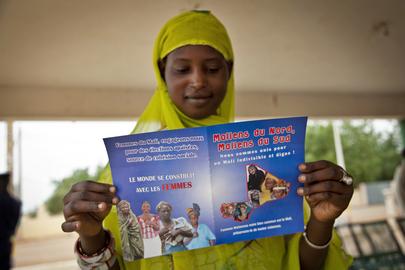
We urgently need to stimulate advocacy and action among civil society, and to push the UN, member states, and international financial institutions to recognise and prioritise gender equality and peace funding.
For this to happen, we need to spread the word that:
Guns don’t promote security; gender equality does;
You get what you pay for… so if you want peace, invest in it; and
There’s a real need to #MoveTheMoney from militarism and war to women’s peace movements!
The tools and resources below can be used for advocacy in your own country. They include as a social media cheat sheet to help you spread the #MoveTheMoney message; a more general guide to using social media; visual materials (including profile pictures) that can be shared on Twitter and Facebook; a guide to media engagement; a report on the WPS Financing workshop; an overview document of the toolkit; and the press release announcing this toolkit.
Whether you’re a grassroots women human rights defenders, a peace activists or a government employee, join us to spread the message that it’s time to #MoveTheMoney!
>>Download our #MoveTheMoney social media cheat sheet
>>Download our social media guide
>>Download our guide to contacting the media
>>Read the press release announcing WPS Financing Toolkit launch
>>Read the report on the WPS Financing workshop in July, 2016
>>Read the overview document about the WPS Financing Toolkit
Please feel free to download and use the following social media graphics, which have been especially made for distribution on Facebook and Twitter:
>>Download the #MoveTheMoney Facebook cover photo
>>Download the #MoveTheMoney Facebook and Twitter profile picture
>>Download the #MoveTheMoney Twitter cover photo
>>Download the #MoveTheMoney Facebook meme 1
>>Download the #MoveTheMoney Facebook meme 2
>>Download the #MoveTheMoney Facebook meme 3
>>Download the #MoveTheMoney Facebook meme 4
>>Download the #MoveTheMoney Facebook meme 5
